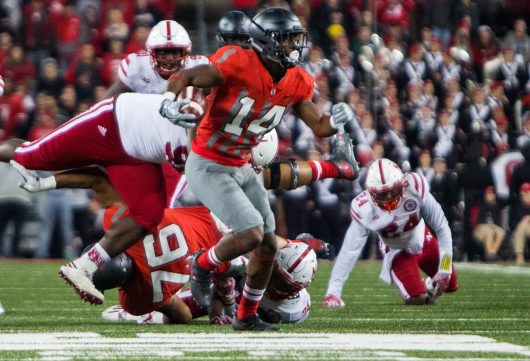
OSU redshirt freshman wide receiver K.J. Hill avoids a tackle during the second half of the Buckeyes game against Nebraska on Nov. 5. The Buckeyes won 62-3. Credit: Alexa Mavrogianis | Photo Editor
Losing Michael Thomas, Braxton Miller and Jalin Marshall from last year’s team was never going to be an easy transition for Ohio State and coach Urban Meyer. The three wide player didn’t put up the most impressive numbers, but they provided a certain amount of explosiveness whenever the ball was in their hands.
The 2016 receiving corps came with some growing pains, but maybe not as aching as Meyer and the rest of the staff expected. In the weeks following redshirt sophomore wide receiver Noah Brown’s four-touchdown performance at Oklahoma, his outstanding performance looked to be an outlier.
However, after last Saturday’s 62-3 thumping of then-No.10 Nebraska, Meyer had a newfound faith in his playmakers.
“It is a little relief to know that, right now, I saw some explosiveness that we kind of have been lacking in some positions,” Meyer said after the game. “And I think ‘relief’ is probably the correct word that we’ve all been waiting for that to happen. And like you said, no better time than the month of November to get that thing going.”
Meyer went back to the the Woody Hayes Athletic Center the next day and came to the same conclusion as he initially thought: The wide receivers were at their best and were a pivotal factor in the offensive outburst.
“They’re coming into their own a little bit. I thought they played fantastic,” he said on Monday. “I thought they blocked well on the screen passes, and that was their best game by far.”
OSU wide receivers and H-backs combined for 24 receptions against Nebraska — seven more than they did versus Northwestern and nine more than at Penn State. Redshirt junior quarterback J.T. Barrett had his best passing game in weeks, throwing for 290 yards and four touchdowns.
The most substantial contributor was junior H-back Curtis Samuel, who had 137 receiving yards and two touchdowns.
The lack of a downfield attack had been highlighted in weeks leading up to Nebraska, despite Barrett and Meyer believing the passing game was at an OK spot. Barrett finally connected on a deep ball to Samuel on the first play from scrimmage in the second half for 75 yards and a touchdown.
Barrett said on Monday that the Nebraska defense showed the same looks in the secondary that Northwestern did at times, but once Barrett completed a pass downfield, that coverage went away. Once downfield coverage switched to more man coverage, Barrett saw Samuel matched up against the nickelback, threw it to a spot and watched six points go on the board.
“There was a lot predicated on the coverage,” Barrett said. “I think teams knew we were definitely capable of doing that and knew we were going to try to do that, so they played off of us.”
Barrett’s lone-pass completion of more than 20 yards against Northwestern was to redshirt freshman K.J. Hill, which set up the game-winning touchdown. Meyer said that a play like that can give a team confidence heading into the next week of practice and the following game. Hill was used extensively in the late quarters, racking up a career-best five receptions and 66 yards. He was also named a champion by Meyer on Saturday.
“He’s earning more and more playing time,” Meyer said. “Very reliable guy, good blocker, always in the right place, very good hands … I’ve seen that happen before. It sparks, energizes the group, and it certainly has.”
The Maryland Terrapins rank seventh in the Big Ten in passing defense, allowing 204 passing yards per game. Star cornerback Will Likely tore his ACL in late October, which has affected the depth of the Terrapin secondary.
OSU involved five different pass catchers on the first drive of the game — a instnace that truly showed the depth of the Buckeye receivers. One game doesn’t justify the group as one of the top units in the country, or even the conference. However, considering Michigan torched Maryland last week for 387 receiving yards, Saturday’s game in College Park could be an early indicator for The Game.


